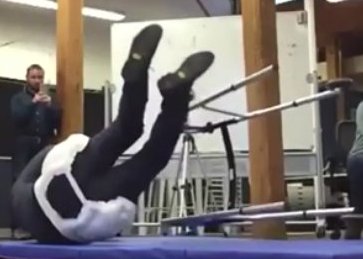

Hip - Airbags: a tech solution to senior falls.
A broken hip is one of the major injuries from
accidental falls. Up to 90% of broken hips are caused by a fall,
and for seniors the results are depressing: half never fully recover to
their former lifestyle and another quarter die within a year of the injury.
Safety hip-pads have been around for quite awhile, but are bulky
and generally unpopular in the senior community.
At least two companies have come up with a hi-tech alternative: the hip-airbag. First, the model from Helite, the Hip-Air:

In this sequence, from a video at the 2018 CES show, the deployment was a bit late.
More info: https://www.theverge.com/2018/1/7/16860374/hipair-elderly-tech-health-fall-prevention-wearables-ces-2018
Next, the Smartbelt, developed in Allentown, PA:

Here, the inflation is quite early, but the elbow strike is not a good thing.
More info: http://www.wfmz.com/news/lehigh-valley/allentown-company-wants-to-save-lives-with-the-smartbelt/680191542
As with any new development, there are many technical challenges.
The computer chip and sensors that detect a fall must have a
sophisticated program that will trigger the airbag inflation quickly
enough; yet still avoid accidental deployment from just "dropping" down
into a
soft chair.
So, are hip airbags a real solution to the senior falling epidemic?
Perhaps not generally. A major problem,
as noted by those in the field, is compliance. Although the new
systems are smaller and less obtrusive than the old and bulky hip pads
and shields, they are still noticeably large. The cost is
relatively high, $800 or so, and every use requires replacement of gas
cylinders at the least. For the average senior, these devices will not be very appealing.
Our Hip Airbag Concerns:
These airbags focus on protecting a single body area: the hip
bone and pelvis. But the major killer in accidental senior
falls is the head-strike with concussion. If the hips are
elevated by an airbag, the head will be even lower towards the floor.
One frame from a testing lab shows this effect well:

Notice that in this picture, and especially in both of the sequences above, the test subjects are already using active safe-falling techniques -- even as they aim to land on their hip area.
Their arms are pulled in close to the body, their core muscles are tight, and their necks are tensed to prevent head-whip.
If seniors need to fall this well when using the hip-airbags, why not also teach them to just sit down?

http://newsroom.aaos.org/images/9064/AAOSFallsGuideFINALPDF.pdf






